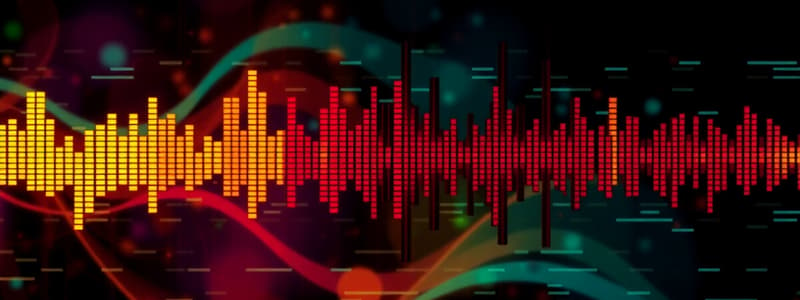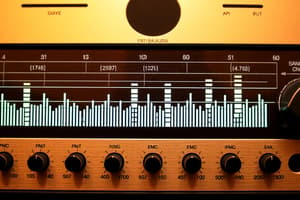Podcast
Questions and Answers
In digital audio, what does the vertical scale of a waveform typically represent?
In digital audio, what does the vertical scale of a waveform typically represent?
- Time-based samples
- Units of frequency
- Bit depth
- Units of amplitude (correct)
What two factors determine the resolution of a sampled audio signal?
What two factors determine the resolution of a sampled audio signal?
- Frequency and amplitude
- Sample rate and file size
- Bit resolution and sample rate (correct)
- Encoding and decoding methods
What is the Nyquist Theorem's core principle regarding digital audio sampling?
What is the Nyquist Theorem's core principle regarding digital audio sampling?
- The bit depth must be double the sample rate.
- The amplitude must be equal to the frequency.
- The highest frequency accurately sampled must be half the sample-rate. (correct)
- The sample rate must be at least four times the highest frequency.
What is the purpose of using a 'status bit' in binary representation of audio signals?
What is the purpose of using a 'status bit' in binary representation of audio signals?
What does the term 'aliasing' refer to in the context of digital audio?
What does the term 'aliasing' refer to in the context of digital audio?
What is the primary function of a Low Pass Filter (LPF) in digital audio processing related to the Nyquist Limit?
What is the primary function of a Low Pass Filter (LPF) in digital audio processing related to the Nyquist Limit?
What is the purpose of over-sampling audio?
What is the purpose of over-sampling audio?
What is the main purpose of 'dithering' in digital audio processing?
What is the main purpose of 'dithering' in digital audio processing?
In the context of error checking, what does 'interpolation' refer to?
In the context of error checking, what does 'interpolation' refer to?
What does the term 'interleaving' refer to in the context of digital audio storage?
What does the term 'interleaving' refer to in the context of digital audio storage?
What is the role of parity bits in digital audio systems?
What is the role of parity bits in digital audio systems?
What is the significance of the R2R ladder circuit in digital audio?
What is the significance of the R2R ladder circuit in digital audio?
What is Pulse Code Modulation (PCM) primarily used for in digital audio?
What is Pulse Code Modulation (PCM) primarily used for in digital audio?
What is the key difference between how audio is stored on a CD-ROM versus a CD-DA?
What is the key difference between how audio is stored on a CD-ROM versus a CD-DA?
What is Direct Stream Digital (DSD) and how does it differ from PCM?
What is Direct Stream Digital (DSD) and how does it differ from PCM?
Which component of a digital audio system serves as the initial and final point for audio signals, managing the transition between analogue and digital formats?
Which component of a digital audio system serves as the initial and final point for audio signals, managing the transition between analogue and digital formats?
What is the impact of having a larger playback buffer in a digital audio system?
What is the impact of having a larger playback buffer in a digital audio system?
In digital audio workstations (DAWs), what benefit does floating point binary provide?
In digital audio workstations (DAWs), what benefit does floating point binary provide?
What is the reason for the digital audio system design to take into account the human hearing limitations?
What is the reason for the digital audio system design to take into account the human hearing limitations?
What is the function of 'interpolation' as a means of error management within file playback?
What is the function of 'interpolation' as a means of error management within file playback?
What would be the result of a binary message composed entirely of zero's being run through an R2R ladder?
What would be the result of a binary message composed entirely of zero's being run through an R2R ladder?
What is the sonic impact of the steep filters required for PCM to cohere to the Nyquist theorem?
What is the sonic impact of the steep filters required for PCM to cohere to the Nyquist theorem?
What is the purpose of 'Interleaving' during a digital audio process?
What is the purpose of 'Interleaving' during a digital audio process?
What is the main advantage of using a Delta-Sigma D~A converter for high sampling rates?
What is the main advantage of using a Delta-Sigma D~A converter for high sampling rates?
What is the relationship between speed, accuracy, and performance in a digital audio system?
What is the relationship between speed, accuracy, and performance in a digital audio system?
Flashcards
Amplitude in Digital Audio
Amplitude in Digital Audio
The amount of signal's strength, measured in positive and negative phases in 16bit.
Sample Rate
Sample Rate
The number of snapshots of a sound taken per second, determining the resolution.
Bit Resolution (Bit Format)
Bit Resolution (Bit Format)
The scale of units of amplitude available which determines dynamic range.
Nyquist Theorem
Nyquist Theorem
Signup and view all the flashcards
Binary Code
Binary Code
Signup and view all the flashcards
Most Significant Bit (MSB)
Most Significant Bit (MSB)
Signup and view all the flashcards
Least Significant Bit (LSB)
Least Significant Bit (LSB)
Signup and view all the flashcards
Nyquist Limit
Nyquist Limit
Signup and view all the flashcards
Over-sampling
Over-sampling
Signup and view all the flashcards
Filtering in Digital Audio
Filtering in Digital Audio
Signup and view all the flashcards
Interpolation in Audio
Interpolation in Audio
Signup and view all the flashcards
Dithering
Dithering
Signup and view all the flashcards
Error Checking
Error Checking
Signup and view all the flashcards
Sample & Hold Circuit
Sample & Hold Circuit
Signup and view all the flashcards
Interpolation (Error Checking)
Interpolation (Error Checking)
Signup and view all the flashcards
Concealment (Error Checking)
Concealment (Error Checking)
Signup and view all the flashcards
Interleaving
Interleaving
Signup and view all the flashcards
R2R Ladder Circuit
R2R Ladder Circuit
Signup and view all the flashcards
Pulse Code Modulation (PCM)
Pulse Code Modulation (PCM)
Signup and view all the flashcards
Pulse-Density Modulation
Pulse-Density Modulation
Signup and view all the flashcards
Direct Stream Digital (DSD)
Direct Stream Digital (DSD)
Signup and view all the flashcards
Sigma-Delta Modulation (SDM)
Sigma-Delta Modulation (SDM)
Signup and view all the flashcards
High Sampling Rates
High Sampling Rates
Signup and view all the flashcards
Digital Decimation Filter
Digital Decimation Filter
Signup and view all the flashcards
Oversampling Explained
Oversampling Explained
Signup and view all the flashcards
Study Notes
- The document contains study notes for digital audio theory.
- The document was revised in the Summer of 2021 by Anthony Norris.
Digital Recording Overview
- The example shown is a single phrase of an acoustic bass played by Nick Heywood.
- The recording was made in 1997 at Woodstock Studios using an AWA Ribbon, MCI Pre, and Telefunken 1176.
- The vertical scale indicates amplitude in 16bit, represented in units.
- The horizontal scale represents time-based samples which relates to sample rate 44,100 per second (Compact Disc Digital Audio).
- The waveform is not strictly linear but consists of steps mapped from a grid.
- The resolution of the grid is determined by sample rate and bit resolution.
- Bit Resolution X 6 is used to calculate the scale of units of amplitude: I.e. 16 x 6 = 96dB (-96dB FS).
- Bass notes have longer waveforms because of their lower cycles per second, pitch, and frequency.
- At A=440, there are 440 waveform cycles per second; the hearing range is around 20,000 per second (20kHz).
- Zooming in shows steps representing the analogue linear signal, with steps representing samples.
- Highlighted section represents a fraction of time with samples, illustrating the arithmetic involved in representing analogue signals.
- Sample Rates of 192,000 per second (192kHz) with an Amplitude scale equal to 144dB SPL (−144dB Full Scale) at 24bit resolution - the human range of amplitude is LESS than this figure; somewhere in the 0~120dB SPL range.
- Selected samples played back may sound like static due to a tiny fraction of Analogue to Digital Conversion.
Binary, Digital Sampling & Nyquist's Theorem
- Nyquist's theorem states the highest frequency accurately sampled and reproduced equals 0.5 times the Sample-Rate (I.e. 22.05kHz at a Rate of 44.1kHz).
- The sample rate must be double the highest frequency to capture, as soundwaves include positive and negative phases. With a 22.05kHz frequency, one full cycle occurs 22,050 times per second.
- Separate samples of both phases need to be clocked at twice the speed (44,100 times per second).
- Digitizing an analogue signal involves measuring the amplitude of the signal in both phases and the speed at which these cycles repeat.
- The amplitude of a signal depends on the system's ability to recognize differing levels of loudness which is the bit format.
- A 24bit recording can capture greater detail in amplitude than the human ear, with 144dB of dynamic range.
- The speed alters these levels of loudness and is determined by the Sample-Rate.
- Encoding: rewriting a digitized signal for computer readability.
- Binary: Computers use this system which represents numbers with switches (on/off) in columns representing numbers, with each column multiplying by two.
- An eight-bit binary message consists of eight columns and base numbers.
- Using example to represent the number 129, the switches would be On, Off, Off, Off, Off, Off, Off, On (because 128 + 1 = 129).
- Binary has the abillity to utilize a STATUS BIT system to represent positive and negative values, the Highest value bit or MSB, is allocated a role to describe the Bits in the sample word.
- An 8-bit word with the MSB expressing positive or negative values means the remaining 7 bits express value, removing 8th bit diminishes Expression range, but expands scope of the 8 bits.
- All bits can express a value range of 0 ~ 255, or Status Bit can give an expression range to the same 8 bits of –127 ~ +127, where the MSB represents the +/- and the remaining 7 bits express a value from 0~127
- The lowest valued bit (LSB) is always required for its base-1 value is 1 so odd values can be expressed.
- *Floating point binary is a similar system that includes an exponent value which represent the position of a decimal point to widen the magnitude change from digitized amplitude.
- "Alias” references the Nyquist Limit.
- When frequencies above the Nyquist “hit” this limit they create "aliases” which point to identical data.
- A "loop" of identical data at a fast rate can be perceived as “distortion;” in the case of samples, because the ear can detect and interpret the duplicate or very similar signals, and rejects them.
- A Low Pass Filter (LPF) attenuates the amplitude of frequencies approaching the Nyquist Limit
Over-sampling, Filtering, Interpolation & Dithering
- During digital sound capture, audio waveform is converted to data through a series of systems.
- The quality of the encoding depends on the steps in the Pulse Code Modulation Sampling routine
- Converters are the first and last point of contact for analogue audio signals, A-D and D-A. They are doorways into and out of the digital system.
- Design components and codex are related to the the initial binary encoding qualities with a codex, and are a series of equations determining “decisions” about calculations.
- 24bit Converters vary in design and codex creating ranges of perceivable “sound quality."
- Over-sampling: Recalculating the initial captured sound to many times the bit resolution.
- The system operates on the digital system using the "8 times” Over-sampling codex, interpolating up to a mathematical, allowing greater “detail” for calculation results.
- 120 dB is a mighty long way to reduce frequencies amplitudes, and if they are reduced too quickly the ear can "notice the unpleasant result”.
- Therefore frequencies must be attenuated at a reduction rate unrecognizable by hearing, this is roughly 3dB for every 3rd of an octave (overall difference is level over entire octave of approximately 9dB)
- By "Over-sampling” to higher value samples are "Interpolated” (internally calculated using the analogue capture method), which is reduced back down to rate and resolution: this process is known as "Dithering".
- Dithering expands a digital system’s math capability through “Over-sampling” before reducing virtual numbers.
- Dithering is another series of equations written as a codex, and is used to carry out “Word-length Reduction" by creating a "psycho-acoustic illusion” that "masks" the artefacts of reduced resolution.
- The two phase process adds a randomised amplitude of "noise” data to a word, which reduces the "Word-length" of data. The "hiss” can hide low amplitudes which would not be recognised if alone, and adds value to the data.
- Noise hides low amplitude changes, and if the noise is slightly louder than the lowest recorded signal it will be possible to regain the shape of the audio through reduced range. Bit resolution is directly responsible for one system’s dynamic range.
- "Re-Dithering” represents any word-length reduction that occurs AFTER initial “Dithering,” which is required after Expansion and calculations. If "Dithering” is applied to the initial processing, Re-Dithering is further application during the process.
Error Checking
- Once a digital system makes its final data word the storage must be prepared, or data can be lost.
- All equations have a limit to their accuracy.
- The "Sample & Hold" circuit is like a queue where each sample is held pending result analysis.
- This queue is a "buffer” built from RAM, where, “checks and verifications" are carried out with pre-existing equations.
- Number of Error checks relates simply to time, and the duration of data in the Sample & Hold circuit, and the length of time it takes to “clear” data for storage.
- Engineers must design an error checking codex to accommodate a trade off between “speed” and “accuracy."
- Time any data is held and no. error checks, are directly correlated to “performance” of the system.
- Common methods codex use to check for errors:
- Interpolation of Missing Data (Data referral).
- Concealment: Amplitude Fade.
- Note: These are often simplified into methods not processes, with codex different between all systems.
- Parity Bits.
- Checksums.
- Interpolation: data used from a missing report is referred against pre error/post error data and averaging is applied. *The further this takes place the more interpolation is applied.
- Concealment: pre error to fade data fading out and post data fading back to conceal the data.
- Parity Bits: data series are checked against "reveal” error location written to data word. CheckSum: absolute length that word/data must equal.
Storage & Interleaving
- Once data has been error corrected and sent to the storage buffer to await storing.
- There is an error acceptance protocol referred to as “Interleaving.”
- Interleaving can be used to conceal errors.
- Interleaving was designed to address access speeds in earlier hardware storage systems; as speeds improves this has reduced as integral aspect of data management
- "Interleaving" does very much refer to audio industry where the format "xxxx" left and right audio data where a single file uses 8bits from left/right audio.
- Types of errors that occur in this stage of our system:
- Random Bit Errors of non or across contiguous data.
- Burst Errors.
- Occur across whole words due to disc access; data fragmented.
- To allow Random Bit Error and re-assemble data in reverse order, a likelihood of continuous error can be avoided. With this removal, data can be sent at streams of 44,100 per second.
- Digital systems mask psycho-acoustic scenarios, and is not an actual adjective of digital recording processes.
Retrieval & Parity-Bits
- Begins “playback” by retrieving data from written state.
- After a buffer has searched and accessed target data, it loads into a buffer; once again being rearranged through interleaving.
- This stage is vital, because it is time sensitive: here it is likely Digital Audio engines need to be cleared on time, and that the system cannot be accurate.
- Speed, Accuracy and Performance are inter-related throughout the system, and are most likely a “trade-off.”
- Latency directly impacts how long the playback buffer is waiting, and errors that occur, because DSP (Digital. Signal. Processer) systems will also cause latency due to the nature of digital processing.
- DSP latency makes it unsuitable for Major studio recording applications as multi tape analogue machines used to be.
- TDM systems allow accurate, error-checked playback across multiple streams and are the preferred method.
- These contain dedicated audio cards with banks of DSP whose principle propose is too carry over massive amounts of data.
Fourier Sine-Wave Theorem & FM Synthesis
- It may be beneficial to under stand the basics of “waveform construction” to recognise how digital data is recorded to analogue signals.
- Complex waveforms:
- Can be re-created by summation and modulation of multiple since waves.
- Yamaha DX was capable of simulating sounds, however that required multiple sine waves as well as modulators. (AM) Amplitude modulations with DX series.
- The same approach to this frequency modulation is the basis for building complex waveforms from sampled data, which can output final review in Fourier displays
The R2R Ladder circuit & Pulse Code Modulation:
- R2R acronym stands for “Resistance to Resistance” that acts as switches with gates and dependent open close.
- There will essentially be a high voltage amplitude of any system due to the nature of lesser voltage.
- For simplified example voltage = 8.
- e.g. A “0” would essentially activate and resist, or a “11011011. is where 0's resist "activated.
- R2R ladder = resistors which lessen passing voltage over circuit a "0000 = Resist and 0 voltage" and therefore switching mechanism has filter for voltage cleans "to clean up output data".
- An R2R ladder is an element/ mechanical that fast like sample rate for definition is like 192 - 192,000
- For sampling rates D ~ A converters a stream of data
- When Voltage levels are too spikey and in coherent this also called glitches/errors, to address this with another "LOw-Pass-Filter".
- DAC with sample rate with .1 khz for example, simple sine by example that looks to replicate the pulse
- The Series of output: for sampling that derives Pulse Code Modulations.
Compact Disc Digital Audio format
- The hard-disk drive media recorder and format for Sony and Philips is CD-DA
- Discs the same used in CD-Rom drives, with the way its actually written is very different due to the nature data in digital audio
- NOT store as numbers but rather pits that are read by laser in Audio Compact Disc players, which tells "frequency and amplitudes" produces by signal.
- They produce radio frequency sound, because pits are "burnt" on its surface with CD burner or pressed disks.
Direct Stream Digital Audio format
-
The principles of Pulse Code Modulation (PCM) audios capture of waveform , CD quality PCM measures the amplitude of a waveform 44,100 times per second and stores each measurement as a 16-bit value.
-
In DSD, the amplitude of the waveform is represented by the relative density of the ones and zeros with the bit Stream.
-
PDM = pulse density modulation
-
Sony claims dynamics = 120 db
-
Higher energy: “1” recorderd.
-
if the energy lower: value is 0 recorded
-
(delta) energy compares to (sigma).
-
Another name for SDM = signa =delta = modulation
-
Frequency response positive effect can extend up to 100khz, Because Nyquist means at a sampling rate is one-half therefore "definition" contains no frequencies that extends 22Khz, at "96K" anything that exceeds 46khz must be be filtered.
-
Frequencies in audio will “influence the color of complex audio tones.
-
DSD: more supreme imagining in stero and surround applications."
-
DSD: steeper filters that conformed to the Nyquist and were better.
-
Common for DSD analog digital coneverter to start at 1 bit, and apply filter decimnation.
Excerpt from White Paper by KORG ©2009
- The top square wave is the original input signal, the bottom is the output. Each picture shows the analog input signal and the output at the given bit resolution and sampling rate. We can see the output signal using 16-bit / 44.1 kHz becomes a sine wave.
- It is strongly recommended that notes be taken during lectures, and lectures are fundamental
Studying That Suits You
Use AI to generate personalized quizzes and flashcards to suit your learning preferences.



